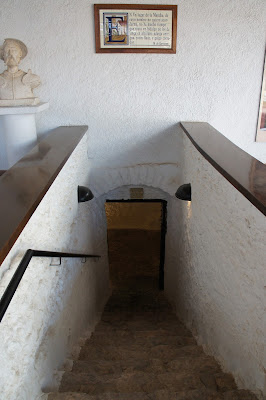 |
| Cave/Prison Entrance |
If you remember, this is the "lugar en La Mancha" where the story begins. Thus, the story goes that Cervantes drew inspiration from the story of this Marquis who was called "the mad knight" while Cervantes was imprisoned in a cave in the hometown of this Marquis. Now, some like to claim that Cervantes was in trouble in the first place because he flirted with Don Rodrigo's niece. This would be interesting if Cervantes' knight were inspired by a personal desire to criticize this parituclar man out of a sense of revenge of some kind. I think it more likely that this man was the one to recognize Cervantes' inaccurate and possibly illegal taxation. I am not sure about this part of the story, but I do see how a man, bored in prison, could begin to formulate his own version of a mad knight.
There is not a lot of information readily available on Don Rodrigo- something I will need to research further when I get the chance. As a result, what we know comes from that painting and that inscription on the ex voto.
 |
| Ex Voto |
This translates (roughly, perhaps) to: "Our Lady the Virgin appeared here before this knight was who sick with a grave illness and abandoned by the doctors as hopeless on the eve of Saint Mathew in the year 1601. He offered himself to Our Lady and promised her a silver lamp, calling her name day and night due to the great pain he had in his head from a great freezing cold that had formed inside."
Essentially what we know is that this man had some illness in his head, described as a coldness, and that he had a reputation for being eccentric. If Cervantes were to put the two ideas together, he may very well have decided that this Knight was suffering from some insanity. From there, he could have decided what form that madness took and what caused it. In his novel, reading causes the madness and the form is riding out into the countryside pretending to be a knight errant from chivalric romances.
This youtube video does a good job of showing you the painting and telling you exactly what you will hear when you visit the town for yourself. The only problem is that it is in Spanish. However, the subtitles really help, so even a minimal amount of Spanish should get you through the gist of it.
YOUTUBE Video
Throughout the rest of the city, Don Quijote and Cervantes are quite literally everywhere!!
 |
| Cervantes |
 |
| Quijote |
 |
| Cervantes |
 |
| Quijote & Sancho |
 |
| Quijote Burgers? |
 |
| Quijote + Hotel = Quijotel |
Part 1 ends with Cervantes claiming to have no further information about the famous Don Quijote after being returned home in the cart, though he knows there is a third sally that occurs after this in Zaragoza. Fortunately, Cervantes runs into an old doctor who has an old box from a nearby hermitage, and this box happens to contain some epitaphs and eulogies for Don Quijote, Sancho, Rocinante, and Dulcinea.
The reason that Argamasilla is very happy about this ending is that it is mentioned by name since it is a group of academicians from there who wrote this little poems. It would only take a quick look at the name of these academicians to know Cervantes was not trying to honor this little town or make any claim about the quality of its education. The names are Ignoramus, Fawner, Capricious, Mocker, Devilkin, and Ticktock. It is obvious these are not meant to be real academicians, and Cervantes has repeatedly used the names of small and not-well-known universities throughout the novel to mock people who claim to have a good education.
It would be like pretending that someone who has a degree University of Phoenix has a degree from Harvard. While seeming to praise this person, Cervantes is clearly mocking them. The ending and the names would perhaps confirm the idea that Cervantes held a grudge towards these people for his imprisonment. He might not have thought highly of them, but he did include them in his novel. So, perhaps, this truly is the lugar en La Mancha responsible for Don Quijote !
It is also seems clear that Cervantes meant this to be somewhat of a final ending. He set it up to write a third sally if he wished, but ended with the tombs and eulogies of deceased characters. He did not anticipate that someone else would write a second part to his novel in spite of this rather tidy ending to the novel. But that will be for the discussion of part 2.
We did not eat here or spend the night. We only spent an hour or so here, so I do not have recommendations about where to stay or eat. It is a small town, so I would suggest to plan only a half day here at most and take more time to see more of La Mancha! But it is definitely a must see on any Don Quijote trip and worth the trip. This image of the cave is well-known and on the news whenever anyone mentions Cervantes, so it's really neat to be a part of that!

No comments:
Post a Comment